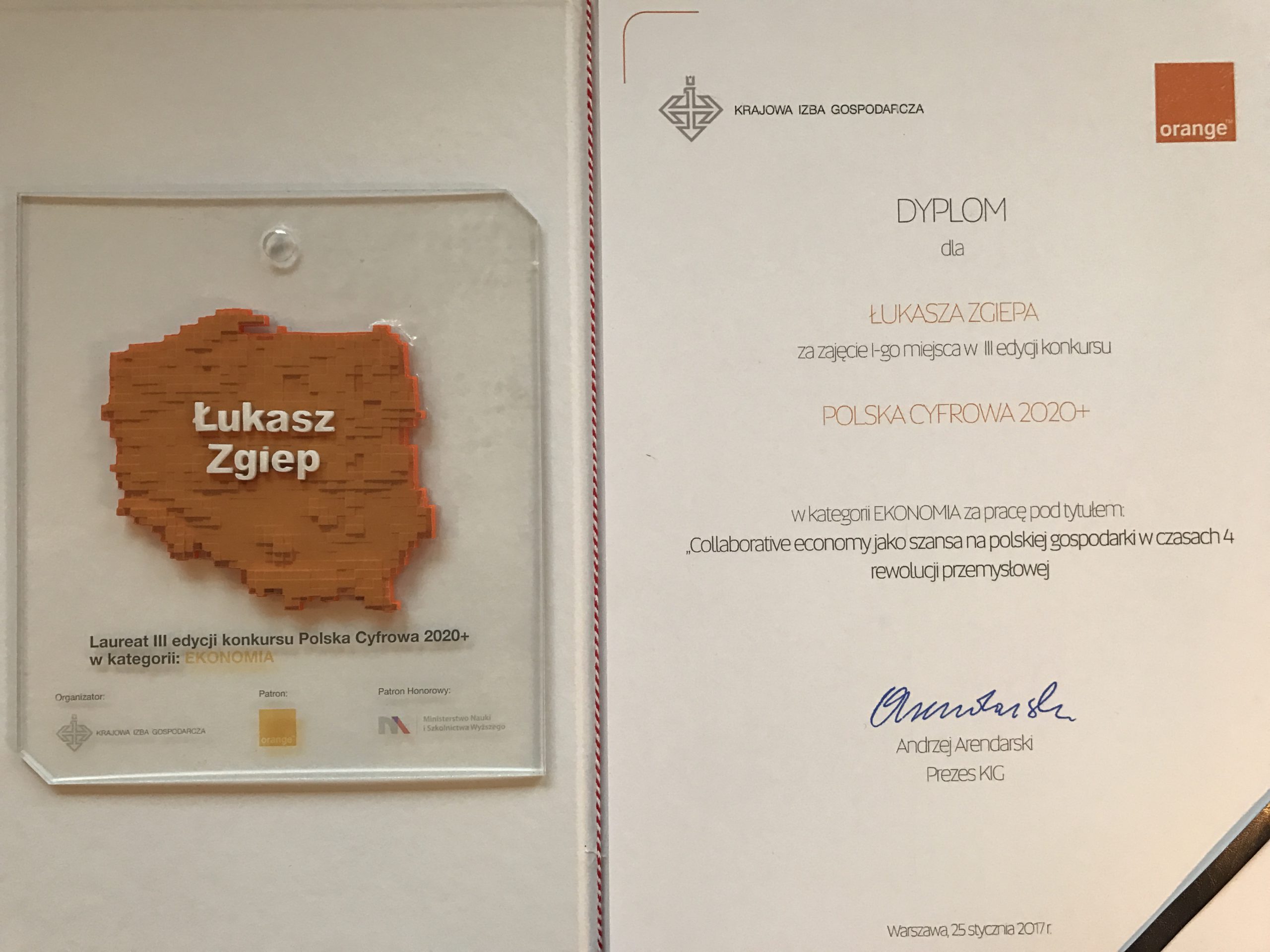I am pleased to announce that I have become a laureate of the Digital Poland 2020+ competition in the ECONOMY category. The competition was organized by the Polish Chamber of Commerce under the patronage of Orange and under the honorary patronage of the Ministry of Science and Higher Education. More information about the contest at the bottom of the page. Below I present parts of my winning work: During the first industrial revolution, Poland lost its independence – in 1772 and 1793 the first and second partition of Poland took place. At a time when other countries had a chance to develop thanks to steam engines, Poland was not on the map, and its inhabitants did not have the opportunity to take part in the first technological revolution. The situation was very similar during the Second Industrial Revolution, which was catalyzed by electricity. In the second half of the 19th century, Poland was still under the rule of Austria, Prussia and Russia, and all the time the inhabitants of Poland were looking for a way to regain independence. During the 3rd industrial revolution (the 1970s), the catalyst of which was silicon, semiconductors and computers, communism reigned in Poland – once again, Poles could not take part in a technologically important global event. At the beginning of the 21st century, for the first time in the history of the world, Poles have a chance to take part in the fourth industrial revolution that is just beginning. Poland as a member state of the European Union – free, independent and democratic has a chance to benefit from the new wave of technology that is spreading around the world. There are many examples in which Poles achieve success, e.g. the recent discovery of the method of mRNA production in medicine and the production of graphene in industry. Table 1. Summary of industrial revolutions Source: Own study. Technology fusion is a collection of new technologies that are developing at an exponential rate, including: artificial intelligence, robotization, internet of things, autonomous cars, 3D printing, nanotechnologies, biotechnologies, new materials, energy storage, quantum computers, drones, virtual reality , virtual assistants, machine learning, advanced investment software. The potential of collaborative economy platforms for the Polish and European economy In June 2016, the European Commission published the European program for collaborative economy, in which it presented its position as an opportunity and potential for the innovative economy of the European Union. The European Commission, bearing in mind the significant benefits of the new CE business models, stated that Europe should be open to new opportunities. The EU should actively support the exploitation of the potential of the collaborative economy in terms of innovation, competitiveness and growth. The EU in its guidelines for member states, entrepreneurs and consumers assures that it plans to support the development of collaborative economy platforms. The preparation of the European program for collaborative economy was preceded by public consultations in each of the Member States. In Poland, the Ministry of Development was responsible for consultations. Taking part in the Polish consultations, I can say that the Polish government, like the EU, sees the potential of collaborative economy platforms and is ready to actively support their development (especially Polish CE companies). Providing services through CE platforms increases liquidity in the labor market compared to traditional business models. People who intend to undertake a specific job can do it more flexibly than in the case of existing forms of employment. Collaborative economy platforms are also in line with the freelance trend. According to the Intuit 2020 Report, over 40% of all employees by 2020 (currently 35%) in the United States will be working on contracts as freelancers. A higher level of employee liquidity may result in a better allocation of their skills and more efficient work, which will bring greater added value and contribute to GDP growth. The undoubted advantage of CE platforms is their ability to continuously improve safety and the quality of services provided. The vast majority of platforms have built-in verification mechanisms for their users. Reputation systems most often take the form of a peer-review of 1-5 stars. Each party to the transaction is required to evaluate the other party upon completion of the service. In this way, the risks of fraud and abuse are very efficiently eliminated, and dishonest entities are excluded in the first situation. This phenomenon can be described by its self-regulation capacity, which as a system efficiently eliminates irregularities. The mechanism of positive selection of reputation systems contributes to the increase of fairness on both sides and the constant improvement of the quality of the services provided. Monopolization of collaborative economy platforms Figure 1. The most popular collaborative economy websites in the United States Source: J. Owyang, A. Samuel, The new rules of the collaborative economy, Visioncritical, 2015, p. 20 Analyzing Figure 1, it can be concluded that the monopolization phenomenon occurs in each of the CE areas. The collaborative economy is an example of a digitized free market that seeks monopoly over the long term. The presented phenomenon may pose a threat to both users and service providers in the future. It is worth considering how to eliminate the emerging threat and what measures can be taken early enough to avoid a situation in which one platform will manage global services in a given sector. More research is needed to better understand the regularities of the collaborative economy market. A chance for the Polish economy the fact that the fourth industrial revolution is the first revolution in the history of the world in which Poland takes part, I dedicate the award to my girlfriend Kamila, who supported me in writing the competition entry and personally picked it up during the Economic Opening of the Year conference. Thank you darling :*

CE platforms, as an important element of the fourth industrial revolution, have a chance to become an important pillar of the Polish economy by 2020. Many of the new technologies that started the fourth industrial revolution have allowed for the rapid development of collaborative economy platforms. Thanks to the network effect and more efficient use of available resources, the benefits of CE platforms significantly increase the quality of people’s lives and contribute to better allocation of employees in the labor market. With the same level of resources, more people can access them at a lower cost. In the history of economics, there has never been a situation where people do not use goods and services that add more value for less money.
The CE market in the United States is much more developed than in Poland. Most of the world’s companies operating in the collaborative economy model are registered in the USA. Research conducted in the US market shows that collaborative economy platforms seek rapid monopolization in their industries. Figure 7 summarizes the most popular collaborative economy platforms in the United States in 2015. Over 50,000 respondents took part in the survey. In 6 of the 9 CE areas presented, the largest platforms have over 50% share in a given market. In transport, Uber has 86% of the market share, its largest competitor Lyft is over 8.5 times smaller (10%), while the third player – Sidecar is only 3%.
Analyzing the full perspective of the economy of cooperation in Poland, Europe and the world, it can be concluded that CE platforms have a positive impact on economic development. They primarily contribute to the improvement of the efficiency of the resources available on the market, better allocation of funds and greater work efficiency, which may translate into GDP growth. It is worth remembering about the dangers related to the monopolization of markets, which occurs much faster on digital platforms than on the traditional market. Given:
European Union support for the development of CE enterprises,
an exponential increase in the number of collaborative economy platform users,
support of the Polish government for the development of CE,
the pace of creating new platforms and business models in Poland and in the world,
numerous benefits for users,
benefits for service providers in the CE model,
more efficient use of available resources,
better meeting the needs of consumers,
improving the quality of life of people using CE platforms,
I believe that collaborative economy is a great opportunity for the Polish and European economy, especially in the times of the fourth industrial revolution that we are witnessing. The European Union and the Ministry of Development of the Republic of Poland are aware of the enormous potential of cooperation economy platforms. Both institutions take into account the support for the development of collaborative economy in the perspective of 2020 and constantly study its impact on the economy. A lot depends on the regulations that will be introduced in this area, both at the national and EU level. The Polish regulator is supposed to support the development of domestic CE companies.





